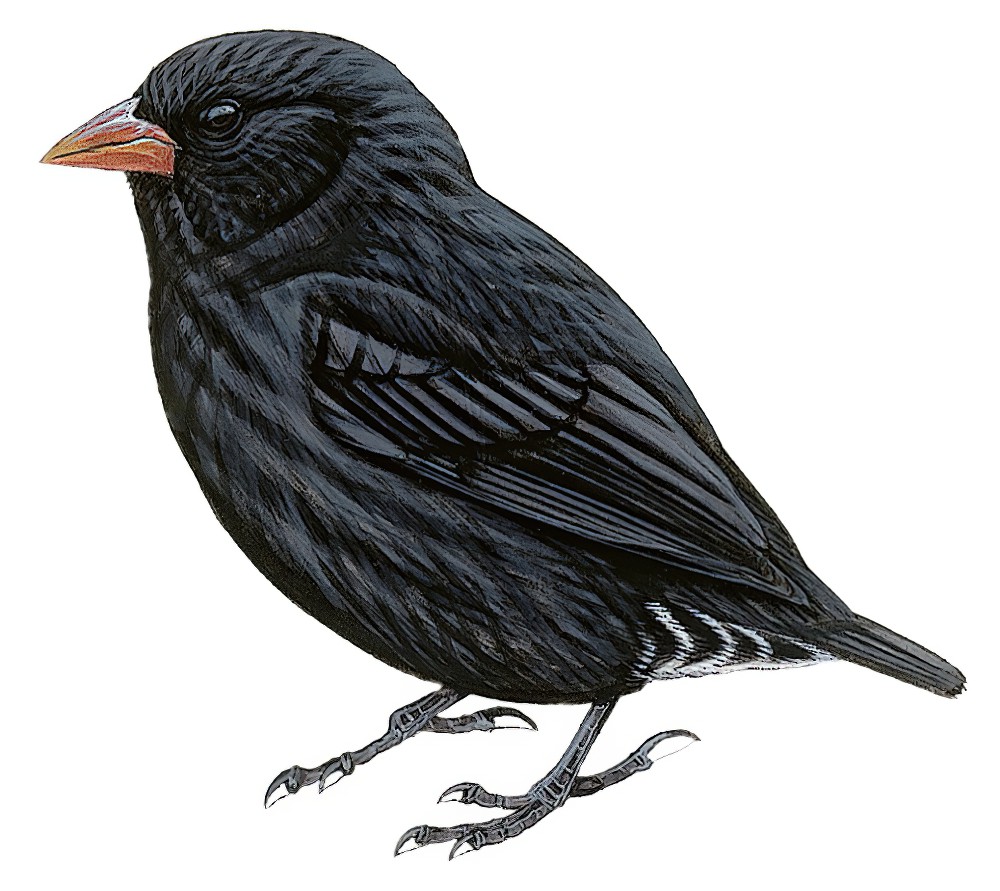Sharp-beaked Ground-Finch / Geospiza difficilis

Sharp-beaked Ground-Finch
SCI Name:
Protonym: Geospiza difficilis Cat.BirdsBrit.Mus. 12 p.12
Taxonomy: Passeriformes / Thraupidae / Geospiza
Taxonomy Code: shbgrf3
Type Locality: Abingdon and Charles, Galapagos Islands ; corrected to Abingdon by Swarth, 1931, Occ. Papers Calif. Acad. Sci., 18, p. 179.
Author: Sharpe
Publish Year: 1888
IUCN Status: Least Concern
DEFINITIONS
GEOSPIZA
(Thraupidae; † Large Ground-finch G. magnirostris) Gr. γεω- geō- ground-, earth- < γη gē earth; σπιζα spiza finch < σπιζω spizō to chirp; "Mr. Gould exhibited from Mr. Darwin's collection of Birds, a series of Ground Finches, so peculiar in form that he was induced to regard them as constituting an entirely new group, containing 14 species, and appearing to be strictly confined to the Galapagos Islands. Mr. Gould believed the whole of these Birds to be undescribed, and remarked that their principal peculiarity consisted in the bill presenting several distinct modifications of form, while the general contour of the species closely assimilated. He proposed to characterize them under the separate generic appellations of Geospiza, Camarhynchus, Cactornis, and Certhidea. GEOSPIZA. Corporis figura brevissima et robusta. Rostrum magnum, robustum, validum, altitudine longitudinem præstante; culmine arcuato et capitis verticem superante, apive sine denticulo, lateribus tumidis. Naribus basalibus et semitectis plumis frontalibus. Mandibula superiori tomiis medium versus sinum exhibentibus, ad mandibulæ inferioris processum recipiendum. Mandibula inferior ad basin lata, hoc infra oculos tendente. Alæ mediocres remige primo paulo breviore secundo, hoc longissimo. Cauda brevissima et æqualis. Tarsi magni et validi, digito postico, cum ungue robusto et digito intermedio breviore; digitis externis inter se æqualibus at digito postico brevioribus. Color in maribus niger, in fœm. fuscus. GEOSPIZA MAGNIROSTRIS. (Spec. typ.)" (Gould 1837); "Geospiza Gould, Proc. Zool. Soc. Lond., 5, p. 5, Oct. 3, 1837—type, by orig. desig., Geospiza magnirostris Gould." (Hellmayr, 1938, Cat. Birds Americas, Pt. XI, p. 130). McKay & Zink 2015, formulate that the ground-finches represent a classic example of Sisyphean evolution, being transient locally adapted ecomorphs trapped before the completion of the speciation process, and that only one species, Darwin's Ground-finch G. magnirostris, should be recognised. Sisyphean encapsulates the endless futility of a fruitless laborious task. In Gr. myth. King Sisyphus of Corinth was punished in the void of eternity by having to push a huge boulder repeatedly up a hill, only for it to roll back before attaining the summit.
Var. Geospitza.
Synon. Cactornis, Cactospiza, Camarhynchus.
• (Passeridae; syn. Montifringilla † White-winged Snowfinch M. nivalis) "Einige wenige größere, aber sonst ähnliche Arten mit längeren Flügeln nennt man Erdfinken, (Geospiza:) weil sie fast beständig auf der Erde leben, und sich bloß auf Steine und Felsen, aber selten oder nie auf Bäume und Sträucher setzen. ... Schneefink. (Fring. nivalis.)" (Gloger 1841); "Geospiza Gloger, 1841, Gemein. Hand- und Hilfsbuch Naturgesch., p. 254. Type, by monotypy, Fringilla nivalis Linnaeus, 1766." (JAJ 2021).
difficilis
L. difficilis difficult, troublesome < dis asunder, apart; facilis easy < facere to make. Coined of species of uncertain systematic position and difficult to allocate, usually as a result of poorly preserved, mutilated, or limited type material.
● "Similar to Cisticola sylvia Reichenow, but striped above and slightly smaller. In general coloration it is not very unlike Cisticola emini Reichenow, though striped and more yellowish above and more strongly fulvous below." (Mearns 1912) (syn. Cisticola natalensis strangei).
● “Although the specimens from the west coast are not sufficiently perfect to allow a full criticism, I am inclined to think that they are really distinct, and that they will not constitute almost the single exception to the fact that no flycatcher is common to both east and west coasts. The colors are lighter, and duller ... The forehead has a peculiar hoary appearance ... In view of all these circumstances, therefore, it may be well to give it provisionally a new name, and none would be more appropriate than that of Empidonax difficilis” (Baird 1858) (Empidonax).
● “The present species was referred by Mr Salvin to G. dentirostris, but the smaller size and differently shaped bill induce me to believe that the two birds are distinct” (Sharpe 1888) (Geospiza).
● "Specimens from the middle area of the Orinoco, the Mérida region, and the state of Carabobo, Venezuela, are referred here with some hesitation. They are not quite typical" (Zimmer 1937) (subsp. Myiodynastes maculatus).
● "Como actualmente não temos presentes os exemplares typicos, não podemos dar descripção mais detalhada; limitamo nos, pois a estes nossos apontamentos e ás informações que amavalmente nos forneceram os srs. Hellmayr e Conde von Berlepsch, ficando reservada para publicação posterior a caracterização mais completa desta especie nova" (Ihering & Ihering 1906) (Phylloscartes).
UPPERCASE: current genus
Uppercase first letter: generic synonym
● and ● See: generic homonyms
lowercase: species and subspecies
●: early names, variants, mispellings
‡: extinct
†: type species
Gr.: ancient Greek
L.: Latin
<: derived from
syn: synonym of
/: separates historical and modern geographic names
ex: based on
TL: type locality
OD: original diagnosis (genus) or original description (species)












